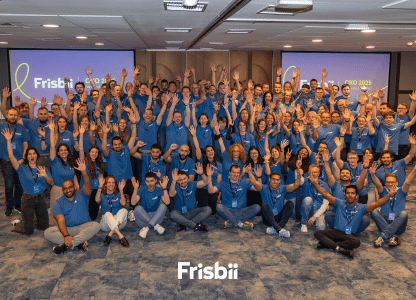Happy Helper is a service platform that connects cleaners and customers easily and transparently. In our interview, CEO Saxo Merrild talks about different service platform approaches, staying lean as a company and why competition doesn’t have to be the enemy.
Overview
- Getting to know Saxo and Happy Helper
- Managing B2B and B2C customers on one platform
- The Happy Helper business model and value
- Acquiring and managing platforms
- Staying lean for more flexibility
- Learnings from acquiring a company
- Keeping in touch with the competition
Getting to know Saxo and Happy Helper #
Juliane: Can you tell us a little bit about yourself?
Saxo: Yeah, my name is Saxo. I’m a 30-year-old entrepreneur.
I started my entrepreneurial journey with a company called Handyhand. Earlier this year, we also got to buy Happy Helper, which has introduced me to Billwerk+.
Juliane: How would you pitch Happy Helper to potential customers and helpers?
Saxo: Happy Helper is a platform that helps cleaners to take care of everything from payment to generation of leads, communication and insurance. It is a way for you to become your own little company.
And for the customer, it is just a seamless way to get connected with private helpers, which provides a different value proposition than booking a cleaning company. You get a more personal contact, and you are protected by the Happy Helper platform with support and insurance.
Juliane: Handyhand is a platform where people can get help for one-time tasks, such as fixing a sink or building IKEA furniture whereas Happy Helper is a lot more about long-term cleaning services. Was that difference a challenge after you acquired Happy Helper?
Saxo: Yeah, it’s definitely been interesting journey going from only running a platform that is more focused on user acquisition than retention.
Handyhand works similar to eCommerce where you try to sell different products over and over again.
On the other hand, Happy Helper is more like a subscription service, where you’re managing churn and customer lifetime value. And that has been very interesting and also a big challenge with a lot of learnings.
Managing B2B and B2C customers on one platform #
Juliane: I recently interviewed Tim Myhrvold from Waitly, a rental waiting list platform. And Tim said that with a platform for B2B and B2C customers, there is a bit of a chicken-egg problem, in who needs to be on the platform first to attract the other clientele. Is that the case with Handyhand and Happy Helper as well?
Saxo: Yeah, it’s a very good point. Again, we have two different platforms. With Handyhand, we found that it was actually easier for us to onboard the demand/the customers first and then sell the demand to potential new helpers because we could show them the tasks that customers needed to be solved.
We were posting to Facebook groups and writing directly to service providers in that area, and that was actually a pretty rockstar value proposition for them: “Sign up & earn money”.
With Happy Helper, we need to have the supply first because it’s very much an offering. When customers tell us that they need a cleaning service in the city at a specific time, the supply has to be ready. And it’s also much easier to onboard the helpers first, because it’s a very specific type of service opposed to the many different services on Handyhand.
Juliane: Speaking of onboarding, who needs more in-person support? Is it the customers or the helpers?
Saxo: I would say that the helpers need more onboarding because they are facing different challenges with different customers every day.
The customer might require some help, but when they’re set up, they’re pretty much good to go.
Juliane: I was wondering how much you have to educate your helpers, since they’re not necessarily seasoned businesspeople who know the ins and outs of legal and compliance topics.
Saxo: Yeah. What we learned from building Handyhand is that you can throw as much as you want into an FAQ but that’s not where most people go.
You want to provide the information that is useful to the user at the exact moment when they need it. I have this rule of thumb: if the information is not part of the user journey on the platform, then users probably won’t see it.
It is good to have blogs and FAQs for your power users and for self-service and SEO, but that’s not where the information should live. It should live in bite-sized snippets, videos and audio clips and whatever else fits. And it should be delivered at the right time of the user journey. That’s much more powerful.
The Happy Helper business model and value #
Juliane: What are the challenges for the customers that your Happy Helper platform solves?
Saxo: First of all, it’s very hard to get someone to give a price upfront.
As a customer, you go online, and you’ll find that most local cleaning businesses will not give you a price upfront. They usually want to come to your place, look at it and then decide on the price which can be a very tedious process for a customer.
We can actually give a price upfront and let people know how much it will cost if they choose a specific kind of helper, frequency, etc.
Second of all, we help find the helper. The customer simply tells us what they need, and we’ll make sure that a helper is chosen who has the time, lives nearby, etc.
And then further down the line, we provide insurance. For example, if a local cleaning company goes bankrupt or breaks something in your home or they cancel the cleaning, you have to deal with the insurance and the company and so forth. Happy Helper supports with all those things, so the whole security structure is there, and you can feel safe no matter what happens.
Last but not least, the payment is much easier. With many local service providers, you’re usually stuck with a very specific payment method whereas with us, you can easily pay as if you’re subscribing to a software-as-a-service.
Juliane: Alright, so that was the customers. And what are the biggest advantages for the helpers to use your platform?
Saxo: I think the biggest advantage is just access to work. A lot of our helpers are either students or people who just moved to Denmark, so it can be quite difficult to get the right connections and options in order to make a living here. Happy Helper can get people started within a matter of hours to start their cleaning business.
And that’s a pretty rockstar proposition in itself.
And then we provide all the utilities that they need to keep track of their different customers, since you usually do not just have one customer if you do private cleanings. And we just make that easy for every single helper we have.
Acquiring and managing platforms #
Juliane: I read that you previously also bought Handyhand and optimized the platform with your own solution. Do you have similar plans with Happy Helper, or do you want to keep the platforms separated?
Saxo: Yeah, we had a bit of experience with taking over legacy code and working with it. We bought this company that had a lot of users and traffic, but their business model and technology needed some work.
So, we stripped their technology away, transferred all their users to our databases, and then just put our technology in that place, under their domain.
With Happy Helper, it’s a bit different, because we don’t want to merge it into our current systems. We want to keep them apart because they are very different business models.
What we are essentially doing is, we’re building a totally new platform because Happy Helper has a legacy platform that could use a bit of an update. And we are actually pretty far with that. We already changed the platform for the helpers and we’re launching an app for the customers as well as the customer platform in December 2024.
In under a year, we’ve actually succeeded in building a whole new platform for both sides of the user group.
Juliane: That’s pretty amazing. I’ve read an interview with you, where you said that you’re a team of about 15 people which is actually not a very big team for two platforms. How do you prioritize tasks to stay efficient?
Saxo: We’ve decided to keep our business very lean. And so, every developer, for example, works full stack and they have a large amount of ownership of the product that they work on. That has allowed us to move fast.
We haven’t scaled the team very much. We have two developers on Happy Helper, and we have four developers on Handyhand, and we want to keep it that way to stay fast and bootstrapped.
Staying lean for more flexibility #
Juliane: In the same interview, you said you don’t have any investors yet, which I think is remarkable nowadays. Do you sometimes wonder if you should get investors involved?
Saxo: We have some minor investors, some angel investors, but we never took that big venture round. To get from zero to one, you’re going to need a little bit of cash. But we do flirt with the idea sometimes and there are people who are interested. And our own stakeholders are also sometimes pushing us a little bit, but we have a proven business case.
We’ve actually built a marketplace with a pretty impressive GMV (Gross Merchandise Volume) and that allows us to fetch money if we would like to.
But I think at the moment, we just really want to see how far we can take it. And what we’ve seen in the Danish market is that we’ve outlived a lot of people who’ve tried to do the same thing, who have either taken more investor money or who have tried to bootstrap it.
And it just feels like our strategy simply works. So, we’re going to keep it that way.
Juliane: The Handyhand platform has its own mobile app. Is there a big difference developing for mobile vs. PC or laptop?
Saxo: There’s always a gap when you start building for web and app. And what we always try to do is keep the interfaces as similar as possible so that they can run on the same backend and so that customers don’t have to learn a whole new interface when they move from one to another.
And what we see is that it’s very powerful to have a great web presence because that’s just a much better acquisition channel. It’s much easier to first generate interest with a low-barrier entry across different channels and better tracking and then move customers to the app which then provides a better user experience and increases the lifetime value.
However, Happy Helper is currently mostly on web because the app is part of the legacy platform which is not working that well. That’s why we will launch a new app in December.
Learnings from acquiring a company #
Juliane: What are your biggest learnings from acquiring a company?
Saxo: I think I’ve learned that it’s better to over-communicate with your user base and your customers. Don’t be afraid to send an email too many. It’s much better than leaving people in the dark. We learned that from taking over Handyhand where we changed the business model quite drastically.
And we tried to communicate it, but we didn’t do enough. We should have been more aggressive in our communication.
Also, if you need to take over a company, then you need to have total buy-in from the company that you’re taking over.
For example, we bought Happy Helper when they went through bankruptcy. And that has only worked because we built a great relationship with the founder that was selling it, so he was more inclined to help us become successful.
If you don’t have this relationship, there will be a lot of internal things that stay hidden until it’s too late. Issues that you just can’t navigate without the help of the prior founders or tech team, etc.
And another learning is to identify what the benefits are for the existing user base and to make sure not to conflate it with the lifetime value of future customers because it might not be the same as the loyal user base that has been built up over years.
What we found out from Happy Helper, for example, was that they had a pretty good revenue base and customers with a very high lifetime value. And we thought it would be pretty easy to just decrease CAC (Customer Acquisition Cost) and keep this CLV. We just needed to figure out the acquisition and then turn it up a notch.
But the lifetime value of new customers was not the same. Those existing customers had been nurtured over many years and new customers were not as loyal. For us, it was going back to the drawing board and identify how we can create an experience for the new users that is good enough to match the CLV of our legacy customers.
Juliane: Yeah, even when some things are tried and true, it doesn’t mean that you shouldn’t also look at other avenues and try new things, because sometimes the market changes and the people change.
Saxo: Yeah, for sure.
Juliane: Do you have considered expanding to different markets outside of Denmark?
Saxo: We’re going back and forth on it. I think Happy Helper makes that perspective more interesting because it’s more of a vertical business. Handyhand is very horizontal, which makes it harder to put into a new market because you need to fill up demand and supply across multiple verticals.
So, we might be looking into it. It’s still a very fragmented market, especially in Europe. There’s some big American players and you got big players in Australia and the UK and Europe. There’s Fresca that’s covering Finland, Sweden, Norway with a cleaning platform, for example. I know in Germany, you have something called MyHammer and others, but nobody has really made that big push to become THE gig platform across multiple markets. And it is just because it’s insanely expensive and it’s very hard to raise that user base across markets.
But I’m not hellbent on doing it. I don’t want to risk what we’ve built in Denmark just to aggressively expand somewhere when I don’t know those markets well enough.
Keeping in touch with the competition #
Juliane: How much do you watch the competition and see what they’re doing?
Saxo: I do watch them, but I mainly try to talk with them, actually.
I try to build community around these things. Because, in Denmark, we’ve now acquired two companies and that’s the way to go because it’s very hard to build a user base.
I’m sure that whoever becomes the largest European player and builds a unicorn around this will be the one who succeeds in putting together these companies in a way nobody else has.
And to be honest, I don’t really care whether I will be acquired or do the acquiring. I just like to keep in touch with the competition, because I admire them a lot.
And I think what they’ve done with Fresca across the Nordics, MyHammer in Germany, Airtasker in Australia and UK – all these companies are doing very interesting things, and we can learn from each other and build the relationship because right now, we’re not really stepping on each other’s toes – until we do.
But even then, it’s so much better to be on good terms.
Billwerk+ provides SaaS and tech platforms with a recurring revenue management platform to handle one-time and recurring payments, subscription management and more for seamless, secure and flexible customer journeys.
Interested? Book a demo to talk about your business case and find the right solution for you.



